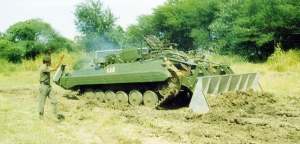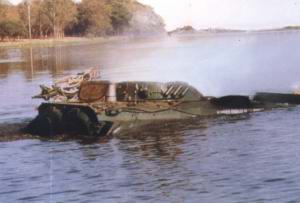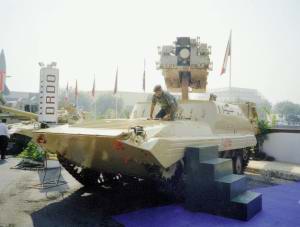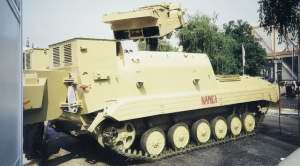| Designation: | Sarath |
 |
|---|---|---|
| Manufacturer: | Ordnance Factory, Medak | |
| Product type: | Armoured Vehicles | |
| Name: | Infantry fighting vehicle |
The Ordnance Factory Medak, owned by the Indian government, has manufactured the Kurgan Machine Construction Plant BMP-2 infantry combat vehicle under licence from the Russian Federation under the local name of the Sarath.
The first vehicle, assembled from components supplied by the Soviet Union, was handed over to the Indian Army in August 1987 and since then the local content of the vehicle has increased year by year and, by 1999, about 90 per cent of the complete vehicle and its associated systems was being built in India.
The Sarath is identical to the BMP-2 covered in detail in a separate entry and is fitted with a two-person turret. It is armed with a 30 mm 2A42 dual-feed cannon, a 7.62 mm PKT coaxial machine gun and a roof-mounted Russian Tula 9K113 Konkurs (NATO AT-5 'Spandrel') ATGW launcher with a maximum range of 4,000 m. This missile is manufactured in India by BDL (Bharat Dynamics Limited).
Since production of the BMP-2 commenced in India, a number of improvements have been incorporated including new radios and modified 30 mm cannon stabiliser.
The Ordnance Factory Medak is responsible for the fabrication of the hull and turret, final assembly and testing as well as manufacturing the torsion bar suspension system, engine and driver's compartment bulkheads, 30 mm and 7.62 mm ammunition storage and feeding systems, the fuel system and missile launcher and missile control system.
Other companies and facilities involved in the programme include the Ordnance Factory Trichy for the 30 mm 2A42 cannon; MTPF Ambarnath for the turret traversing and elevating mechanism and part of the missile launcher; Gun Carriage Factory Jabalpur for main gun mount and 81 mm smoke grenade launchers; OLF Deharadun, day and night vision devices and the gunsight; BEML KGF for transmission and final drives; BELTEX Madras for 30 mm cannon gun stabiliser and electrical cables; and BDL Medak for the missile and launcher.
It is estimated that by mid-2007, total production of the BMP-2 in India amounted to about 1,250 vehicles and these serve alongside about 700 (although some sources have quoted a lower figure of 350) BMP-1 infantry fighting vehicles.
This is already in production and is the basic amphibious BMP-2 modified for the ambulance role with the turret being retained but the armament removed.
The vehicle can be quickly configured to carry four stretcher patients or two stretcher patients and four seated patients or eight seated patients. It normally has a four-man crew consisting of driver, commander and two medical attendants and has a laden weight of 12,200 kg.
Medical equipment fitted includes stretchers, blood/saline bottles, blood transfusion equipment, oxygen equipment, ice container and fresh water container.
The Engineer Reconnaissance Vehicle (ERV) is currently at the prototype stage and has been developed to meet the requirements of the Indian Engineers.
The vehicle retains the hull and turret of the standard production BMP-2, but the armament has been removed apart from the bank of three electrically operated 81 mm smoke grenade launchers either side of the turret. Like the BMP-2, the ERV is fully amphibious, being propelled in the water by its tracks.
The ERV is fitted with all the equipment required to acquire, record and transmit reconnaissance information back to the command post so enabling the engineers to cross both dry and water obstacles.
Equipment installed on the ERV includes a gyro land navigation system, global positioning system, radio navigation and guidance system, hand-held recording conpenetrometer to test soil, electronic distomat and theodolite, water current meter, echo-sounder, laser range-finder and picket driving and trail blazing equipment.
The picket driving and trail blazing equipment is mounted on the left side of the hull towards the rear and enables the ERV to quickly mark the path for the following vehicles. When travelling, this is in the horizontal position and when required for action is swung into the vertical position. The marking rods are fired into the ground using the electropneumatic system, with the magazine holding 50 rods.
All the instruments on the ERV have been integrated through serial interfaces and the data is logged in a 386 ruggedised IBM-compatible PC.
Standard equipment includes a roof-mounted air conditioning system, NBC system, two bilge pumps and a gyro direction indicator. Details of this vehicle are given in Jane's Military Vehicles and Logistics.
This Armoured Amphibious Dozer (AAD) has also been developed to meet the requirements of the Indian Army Engineers and is a BMP-2 with its turret removed and extensive modifications carried out to its hull to enable it to undertake its new mission.
The vehicle has a two-man crew consisting of the driver and operator who are seated back-to-back and are provided with a dual control system.
Standard equipment includes a hydraulically operated earth bucket at the rear with a capacity of 1.5 m3, winch with a capacity of 8,000 kg, front-mounted track with mine ploughs and a rocket-propelled earth anchor, which is similar to that fitted to the now BAE Systems Land Systems Combat Engineer Tractor which has been in service with India for some years.
The rocket-propelled earth anchor is used for self-recovery and has a maximum range of between 50 and 100 m depending on a number of factors.
The vehicle has a maximum road speed of 60 km/h and a water speed of 7 km/h. It is provided with an NBC system and in the future an autonomous version could be developed for use in hazardous areas. Details of this vehicle are given in Jane's Military Vehicles and Logistics.
This uses a modified and stretched BMP-2 chassis with seven roadwheels each side compared to the six of the standard vehicle. Mounted on the roof of the vehicle is a rotatable launcher with three Akash surface-to-air missiles (SAM) in the ready to launch position.
The associated multifunction 3-D phased radar used with the Akash SAM system also has the stretched chassis with seven roadwheels, as does the associated command post vehicle. Both these feature a raised superstructure. This system has yet to enter quantity production.
Additional details of this system are given in Jane's Land-Based Air Defence.
The chassis of the Sarath has been modified to launch the Trishul SAM, with three missiles being carried in the ready to launch position, search and track radars and their associated fire-control system.
In addition, there is a mobile command post with a raised superstructure, which is the nerve centre of the missiles' command, control, communications and intelligence functions. This system has yet to enter quantity production.
Additional details of this system are give in Jane's Land-Based Air Defence.
The Indian Army is to deploy a new self-propelled anti-tank missile system called Namica, which is based on the locally manufactured Sarath tracked infantry combat vehicle chassis.
The Namica is armed with the locally designed and manufactured Nag (Cobra) anti-tank guided weapon (ATGW) that has been under development for some years by the Defence Research and Development Organisation (DRDO).
A total of four Nag ATGWs are carried in the ready-to-launch position, with additional missiles being stowed inside. These can be reloaded from within the vehicle under full armour protection.
Nag weighs 42 kg at launch, has a range of more than 4,000 m and is of the fire-and-forget type. A tandem High-Explosive Anti-Tank (HEAT) warhead is fitted to counter Main Battle Tanks (MBTs) fitted with explosive reactive armour (ERA).
Three different seekers have been developed for Nag: Charge Coupled Device (CCD) based day version, Mercury Cadmium Telluride (MCT) Focal Plane Array sensor-based Imaging Infra Red and Millimetric Wave (MMW) active radar seeker for all-weather target engagement. It uses the Lock On Before Launch (LOBL) concept. The version with the CCD seeker is expected to be the first version of Nag to enter production.
As well as being launched from the Namica, Nag will also be launched from a standard ground firing post and the Advanced Light Helicopter, which will have eight missiles in the ready to launch position. As of mid-2007, it is understood that quantity production of the Nag had yet to commence.
This has its turret removed and it is fitted with an 81 mm mortar, for which 108 rounds are carried. More than 100 of these have been delivered to the Indian Army and details are given in a separate entry.
This is the BMP-2 with the turret removed and replaced by the French Nexter Systems (previously Giat industries) TS-90 two-man turret armed with a 90 mm gun and 7.62 mm coaxial machine gun.
This version was developed to replace the Russian-supplied PT-76 light tank armed with a 76 mm gun. Two prototypes were completed but in the end a decision was taken not to proceed with this model.
The Sarath chassis has been modified to accept the Indian-manufactured 105 mm Field Gun which fires ammunition of the separate loading type that is similar to that used in the 105 mm Light Gun.
This fires a high-explosive projectile to a maximum range of 17,200 m. It is believed that this system is still at the prototype stage. Details of the standard towed 105 mm gun are given in a separate entry.
In production. In service with the Indian Army. As far as is known, India has not exported any of its locally built BMP-2 vehicles or variants based on this chassis. In the longer term the Sarath IFV will be supplemented by the Abhay IFV currently under development.
 |
 |
 |
 |
